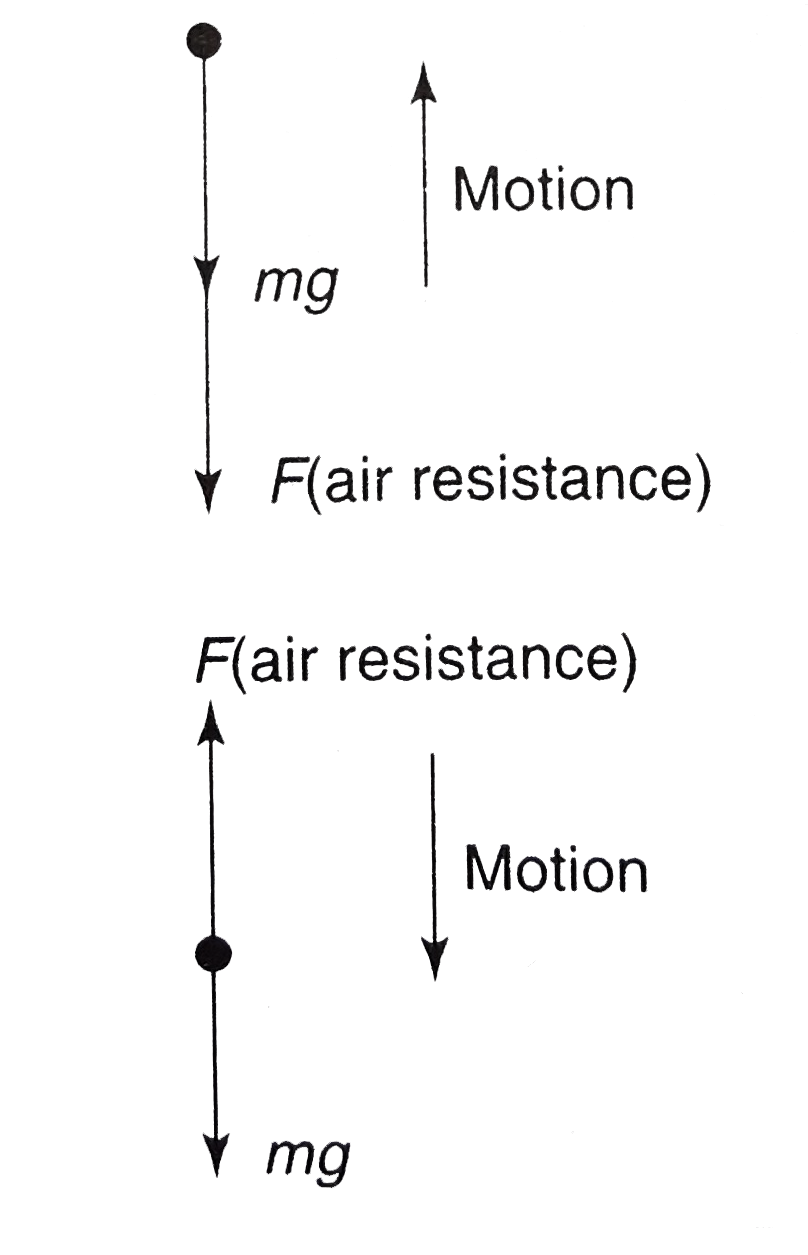Assertion: if air resistance is considerd then time to ascent and time of desent will be different.
Reason: Magnitudes of acceleration will be different in upwards and downward motion.
If both assertion and reason are true and reason is the correct explanation of assertion.
If both assertion and reason are true but reason is not the correct explanation of assertion.
If assertion is true but reason is false.
If assersion is false but reason is true.
The correct Answer is:A
 .
.
Topper's Solved these Questions
- BOOK - A2ZCHAPTER - GENERAL KINEMATICS AND MOTION IN ONE DIMENSIONEXERCISE - NEET Questions37videos
GENERAL KINEMATICS AND MOTION IN ONE DIMENSION
- BOOK - A2ZCHAPTER - GENERAL KINEMATICS AND MOTION IN ONE DIMENSIONEXERCISE - AIIMS Questions20videos
GENERAL KINEMATICS AND MOTION IN ONE DIMENSION
- BOOK - A2ZCHAPTER - GENERAL KINEMATICS AND MOTION IN ONE DIMENSIONEXERCISE - Problem Based On Mixed Concepts30videos
GENERAL KINEMATICS AND MOTION IN ONE DIMENSION
- BOOK - A2ZCHAPTER - FLUID MECHANICSEXERCISE - Chapter Test29videos
FLUID MECHANICS
- BOOK - A2ZCHAPTER - GRAVITATIONEXERCISE - Chapter Test29videos
GRAVITATION
Similar Questions
A player throwsa a ball upwards with an initial speed of 29.4ms−1.
(i) What is the direction of acceleration during the upwared motion of the ball?
(ii) What are the velocity and acceleration of the ball at the highest point of its motion?
(iii) Choose the x=0 and t=0 to be the location and time of the ball at its highest point, vertically downward direction to be the positive direction of X-axis, and give the signs of positive, velocity and acceleration of the ball during its upward, and downward motion.
(iv) To what height does the ball rise and after how long does the ball return to the player's hand?( Take g=9.8ms−2, and neglect air resistance).View SolutionA player throws a ball upwards with an initail speed of 129.4 ms^(-1)(a)Wˆisthedirectionofae≤rationdur∈gtheupwardmotionoftheball?(b)Wˆarethevelocityanda≤rationoftheballattheighestp∮ositsmotion.(c)Ch∞sethe =x 0 aand t=0 be the loction and time at its highest point, vertically downward direction to be the positve direction of X−aξsandgivethesig≠ofposition,velocityandaelrationoftheballdur∈gitsupward,anddownwardmotion.(d)Towˆhightdoestheballriseandafterhowlongdoestheballreturns→theplausrs hands. (Take g= 9.8 ms^(-23) and begleact air resistance)
View Solution
Knowledge Check
- Question 1 - Select One
Assertion: Air above the fire at some distance is hotter than the air below it at the same distance.
Reason: Air surrounding the fire carries more heat upwards than downwards.AIf both assertion and reason are correct and reason is a correct explanation of the assertion.BIf both assertion and reason are correct but reason is not the correct explanation of assertion.CIf assertion is correct but reason is incorrect.DIf assertion is incorrect but reason is correct. - Question 2 - Select One
A : In the presence of air resistance, if the ball is thrown vertically upwards then time of ascent is less than the time of descent.
R : Force due to air friction always acts opposite to the motion of the body.AIf both Assertion & Reason are true and the reason is the correct explanation of the assertion, then mark (1).BIf both Assertion & Reason are true but the reason is not the correct explanation of the assertion, then mark (2).CIf Assertion is true statement but Reason is false, then mark (3).DIf both Assertion and Reason are false statement, then mark (4). - Question 3 - Select One
In the above question , the reason for the bodies to have different times of descent is
AThey have same massBThey have same radiusCThey have different radii of gyrationDAll
Assertion If in a projectile motion, we take air friction into consideration, then tascent<tdescent.
Reason During ascent, magnitude of retardation is greater than magnitude of acceleration during descent.View SolutionAssertion:- When we see the image in water, blurred image is seen.
Reason:- Refractive index of air and water are different.View SolutionAssertion : If a pendulum is suspended in a lift and lift accelerates upwards, then its time period will decrease.
Reason : Effective value of g will be ge=g+aView SolutionAssertion :- Different aged rock sediments contain fossils of different life forms.
Reason :- Certain life forms are restricted to certain geological time-spans.View SolutionAssertion : An electron and a proton are accelerated by same potential difference and then enter in uniform transverse magnetic field. The radii of the two will be different.
Reason : Charges on them are different.View Solution

